avia.wikisort.org - Aerodrome
Gimpo International Airport (Korean: 김포국제공항; Hanja: 金浦國際空港), commonly known as Gimpo Airport (IATA: GMP, SEL, ICAO: RKSS), formerly rendered in English as Kimpo International Airport, is located in the far western end of Seoul, some 15 km (9 mi) west of the Central District of Seoul. Gimpo was the main international airport for Seoul and South Korea before being replaced by Incheon International Airport in 2001. It now functions as Seoul's secondary airport. In 2015, 23,163,778 passengers used the airport, making it the third largest airport in Korea, as it has been surpassed by Jeju International Airport.
This article needs additional citations for verification. (July 2009) |
Gimpo International Airport 김포국제공항 金浦國際空港 Gimpo Gukje Gonghang | |||||||||||||||
|---|---|---|---|---|---|---|---|---|---|---|---|---|---|---|---|
 Domestic terminal (before refurbishment) | |||||||||||||||
| |||||||||||||||
| Summary | |||||||||||||||
| Airport type | Public | ||||||||||||||
| Owner | Ministry of Land, Infrastructure and Transport | ||||||||||||||
| Operator | Korea Airports Corporation | ||||||||||||||
| Serves | Seoul Capital Area | ||||||||||||||
| Location | Gangseo District, Seoul, South Korea | ||||||||||||||
| Opened | 27 January 1958 | ||||||||||||||
| Hub for | |||||||||||||||
| Elevation AMSL | 18 m / 58 ft | ||||||||||||||
| Coordinates | 37°33′29″N 126°47′26″E | ||||||||||||||
| Website | www | ||||||||||||||
| Maps | |||||||||||||||
 Seoul in South Korea | |||||||||||||||
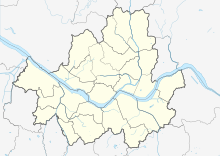 GMP /RKSS Location in Seoul  GMP /RKSS Location in South Korea | |||||||||||||||
| Runways | |||||||||||||||
| |||||||||||||||
| Statistics (2019) | |||||||||||||||
| |||||||||||||||
Statistics from KAC[1] | |||||||||||||||
| Gimpo International Airport | |
| Hangul | 김포국제공항 |
|---|---|
| Hanja | 金浦國際空港 |
| Revised Romanization | Gimpo Gukje Gonghang |
| McCune–Reischauer | Kimp'o Kukche Konghang |
The airport is located south of the Han River in western Seoul. The name "Gimpo" comes from the nearby city of Gimpo, of which the airport used to be a part.
On 29 November 2003, scheduled services between Gimpo and Haneda Airport in Tokyo, Japan resumed. Services to Shanghai Hongqiao International Airport resumed on 28 October 2007. Services to Kansai International Airport in Osaka, Japan started on 26 October 2008. Services to Beijing Capital International Airport started on 1 July 2011.[2] Services to Taipei Songshan Airport started on 30 April 2012.[3]
History
The airfield was originally constructed in 1935–1942 during the Japanese Imperial period as an Imperial Army base. The runways were built on a bed of rocks manually hauled by Korean laborers from Kaihwasan and Yangchan, several miles from the base.[4] Then known as Keijo New Airfield (京城新飛行場), Kimpo was constructed with four runways to supplement the much smaller Keijo Airfield (京城飛行場), which was later known as Yeouido Airport.[5]
Korean War
Gimpo played a major role during the Korean War, and the USAF designated the airfield as Kimpo Air Base or K-14.[6]
North Korean forces attacked South Korea on 25 June 1950 starting the Korean War. During one of the first Korean People's Air Force (KPAF) attacks on 25 June a Military Air Transport Service C-54 Skymaster was destroyed on the ground at Gimpo. On 27 June US naval and air forces began evacuating 748 US diplomats, military dependents, and civilians by air transport from Kimpo and Suwon Airfield.[7] On the afternoon of 27 June five F-82 Twin Mustangs of the 68th Fighter Squadron and 339th Fighter Squadron were escorting four C-54 Skymaster aircraft out of Kimpo when the C-54s were attacked by five KPAF Lavochkin La-7 fighters. In the subsequent dogfights, three LA-7s were shot down for the loss of no US aircraft in the first air battle of the war.[8] Later that day four F-80Cs of the 35th Fighter-Bomber Squadron shot down four Ilyushin Il-10s for no losses over Gimpo in the USAF's first jet-aircraft victory.[7]
Gimpo was captured by the KPA shortly after the capture of Seoul on 28 June 1950. On 29 June eight B-29s of the 19th Bomb Group bombed Gimpo and the Seoul railyards.[7] By July the KPAF were using the base for attacks on UN forces, on 10 July, seven Yak-7s were hidden at Gimpo and used in strikes against UN positions at Cheongju. The next day they surprised and damaged several F-80s in the area. On 15 July the US launched an attack on Gimpo, destroying two or three of the seven Yak-7s there and damaging the runway.[9] On 5 August 5th Air Force fighters strafed and bombed Gimpo, destroying 9 aircraft and damaging 9 others.[9]: 102
Following the Inchon landings on 15 September 1950, the 2nd Battalion 5th Marines was ordered to seize Gimpo on 17 September.[10] Gimpo was defended by a conglomeration of half-trained fighting men and service forces and by the morning of 18 September the Marines had secured the airfield. The airfield was in excellent shape as the North Koreans had not had time to do any major demolition.[10]: 61 On 19 September, the U.S. Army Corps of Engineers repaired the local railroad up to eight miles (13 km) inland and 32 C-54 transport planes began flying in gasoline and ordnance. VMF-212 was one of the first units to operate from Gimpo before moving forward to Yonpo Airfield. On 25 September the 811th Engineer Aviation Battalion began repairing bomb damage on the 6,000 feet (1,800 m) asphalt runway at Gimpo and covering it with Marston Matting.[9]: 178–9 On 6 October the USAF took control of Gimpo from the USMC.[7]
Following the Chinese Third Phase Campaign and the defeat of UN Forces at the 38th Parallel, on 5 January 1951 General Ridgway ordered the evacuation of Seoul and the withdrawal of UN forces to a new defensive line along the 37th Parallel. Units based at Gimpo were withdrawn to the south and facilities were destroyed to prevent their use by Chinese and North Korean forces.
UN Forces resumed the offensive again in late January 1951 and launched Operation Thunderbolt on 25 January with the aim of pushing Chinese and North Korean forces back north of the Han River. By 10 February 1951, UN forces once again had control of Gimpo.[9]: 293
USAF units based at Gimpo (Kimpo) included:
- 4th Fighter Wing operating F-86s from 23 August 1951 to 1 October 1954, subordinate units included:
- 8th Fighter-Bomber Wing from 25 June to 23 August 1951
- 51st Fighter-Interceptor Wing from 10 October 1950 to 10 December 1950, subordinate units included:
- 16th Fighter-Interceptor Squadron operating F-80s from 22 October 1950 to 3 January 1951
- 25th Fighter-Interceptor Squadron operating F-80s from October 1950 to November 1951
- 67th Tactical Reconnaissance Group from 20 August 1951 to 6 December 1954, subordinate units included:
- 68th Fighter Squadron operating F-82s from 30 November 1950 to March 1951 and from 27 June to 24 August 1951
- 80th Fighter Squadron operating P-51s from 27 October to 20 December 1950
Other UN units based at Gimpo (Kimpo) included:
- No. 77 Squadron RAAF operating Gloster Meteors from June 1951
On 21 September 1953 North Korean pilot No Kum-Sok defected in his MiG-15 landing at Gimpo.
- Mitsubishi Ki-51s at Kimpo, October 1945
- Wreckage of C-54 destroyed on ground by KPAF fighters, June 1950
 Captured KPAF Ilyushin Il-10, September 1950
Captured KPAF Ilyushin Il-10, September 1950- F51s at Kimpo (K14) Airfield, October 1950
- Engine change on an F-86E, 1952
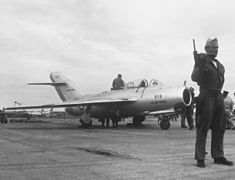 MiG-15, 1953
MiG-15, 1953
International era

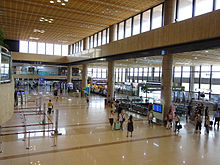
In 1958, the airport was redesignated as the Gimpo international airport of Seoul by a presidential decree, completely replacing the existing Yeouido Airport.[11]
Following the construction of Gimpo, Yeouido Airport was demolished. Gimpo soon became the main airport of Seoul, and of South Korea in general. In 1971, a new, combined domestic and international terminal was opened. However, following the opening of what was known as Terminal 1 in 1977, the original combined terminal was converted to domestic flights only. Later, Terminal 2 was opened due to the Olympic Games.
Gradually, Gimpo began to have more flights than it was capable of handling. After about 1980, it experienced numerous problems due to its lack of space for expansion. An additional problem was South Korea's overnight curfew (midnight to 4 a.m.), a security measure that was in effect for decades. The curfew, which severely limited the airport's night-time operations, was finally abolished in 1982.
Eventually, the South Korean government decided to build a new airport. The facility was initially planned to be in Cheongju, 124 kilometres away from Seoul, but that idea was strongly opposed by the citizens of Seoul and Gyeonggi Province, due to the inconvenience it would pose to them. (It would have been farther from Seoul than the 80-kilometre distance between Viracopos Airport in Campinas, Brazil, and the city of São Paulo.) Finally, Yeongjong Island, a part of the city of Incheon, slightly west of Seoul, was chosen for the new airport, which later came to be known as Incheon International Airport. All international flights were moved to Incheon when it opened in 2001.[12]
Post-Incheon-activation era
"Shuttle" flights to Haneda Airport in Tokyo started in November 2003 on a charter basis, cutting 30 minutes or more of ground transportation at each end in an attempt to attract business travelers.[13] This "city to city" route was followed by new routes to Hongqiao Airport in Shanghai starting in October 2007,[14] Kansai Airport in Osaka starting in 2008,[12] Beijing starting in July 2011,[15] and Songshan Airport in Taipei starting in April 2012.[16] Total international passenger numbers at Gimpo rose from under one million in 2005 to over four million by 2012.[12]
Korea Airports announced an expansion and remodeling of the terminals in 2013, adding new gates and security checkpoints.[17] In 2017, the South Korean government announced that a new terminal would be built to meet growing domestic traffic.[18]
Gimpo currently has two runways (3600 m × 45 m & 3200 m × 60 m), two passenger terminals, and one cargo terminal.[needs update]
Airlines and destinations
| Airlines | Destinations |
|---|---|
| Air Busan | Busan, Jeju, Ulsan |
| Air Seoul | Jeju[19] |
| All Nippon Airways | Tokyo–Haneda |
| Asiana Airlines | Beijing–Capital, Gwangju, Jeju, Osaka–Kansai, Shanghai–Hongqiao, Tokyo–Haneda, Yeosu |
| China Airlines | Taipei–Songshan |
| EVA Air | Taipei–Songshan |
| Fly Gangwon | Yangyang[20][21] |
| Hi Air | Jeju, Muan, Sacheon, Ulsan |
| Japan Airlines | Tokyo–Haneda |
| Jeju Air | Busan, Jeju, Osaka–Kansai |
| Jin Air | Busan,[22] Jeju, Pohang–Gyeongju,[23] Sacheon,[24] Yeosu[25] |
| Korean Air | Beijing–Capital, Busan, Jeju, Osaka–Kansai, Shanghai–Hongqiao, Tokyo–Haneda, Ulsan |
| T'way Air | Busan,[26] Jeju, Taipei–Songshan (begins 16 December 2022)[27] |
Statistics
Top carriers
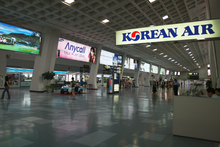

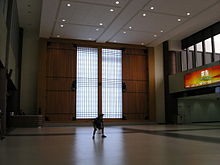
In 2016, the ten carriers with the largest percentage of passengers flying into, out of, or through Gimpo International Airport are as follows:
| Rank | Carrier | Domestic passengers |
International passengers |
Total | % |
|---|---|---|---|---|---|
| 1 | Korean Air | 5,215,514 | 1,220,978 | 6,436,492 | 25.70% |
| 2 | Asiana Airlines | 4,088,721 | 1,123,109 | 5,211,830 | 20.81% |
| 3 | Jeju Air | 2,740,861 | 244,915 | 2,985,776 | 11.92% |
| 4 | Jin Air | 2,926,195 | 2,926,195 | 11.68% | |
| 5 | Eastar Jet | 1,956,905 | 54,663 | 2,011,568 | 8.03% |
| 6 | Air Busan | 1,987,427 | 866 | 1,988,293 | 7.94% |
| 7 | T'way Air | 1,787,123 | 70,992 | 1,858,115 | 7.42% |
| 8 | All Nippon Airways | 424,542 | 424,542 | 1.70% | |
| 9 | Japan Airlines | 388,466 | 388,466 | 1.55% | |
| 10 | China Eastern Airlines | 194,044 | 194,044 | 0.77% |
Traffic by calendar year
| Passenger volume | Aircraft operations | Cargo tonnage | |
|---|---|---|---|
| 2001 | 22,041,099 | 154,164 | 708,073 |
| 2002 | 17,092,095 | 128,428 | 302,240 |
| 2003 | 16,880,641 | 126,343 | 290,731 |
| 2004 | 7,674,153 | 52,212 | 175,850 |
| 2005 | 13,448,152 | 94,787 | 272,304 |
| 2006 | 13,766,523 | 94,943 | 274,368 |
| 2007 | 13,811,004 | 100,124 | 248,736 |
| 2008 | 14,264,693 | 108,015 | 203,977 |
| 2009 | 15,369,944 | 115,895 | 230,115 |
| 2010 | 17,565,901 | 118,514 | 226,493 |
| 2011 | 18,513,927 | 126,115 | 260,135 |
| 2012 | 19,429,224 | 130,269 | 254,563 |
| 2013 | 19,904,327 | 134,623 | 246,227 |
| 2014 | 21,566,946 | 138,706 | 271,990 |
| 2015 | 23,163,778 | 142,863 | 271,066 |
| 2016 | 25,043,299 | 146,266 | 274,712 |
| 2017 | 25,101,147 | 145,507 | 266,428 |
| 2018 | 24,602,588 | 141,080 | 267,266 |
| 2019 | 25,448,416 | 140,422 | 253,395 |
| 2020 | 17,446,239 | 113,580 | 142,380 |
| Source: Korea Airports Corporation Traffic Statistics[28] | |||
Other facilities
Korea Airports Corporation (KAC) has its headquarters on the airport property.[29]
The Aviation and Railway Accident Investigation Board (ARAIB) has its FDR/CVR Analysis and Wreckage Laboratory on the property of the airport.[30] When the predecessor agency Korea Aviation Accident Investigation Board (KAIB) existed, its CVR/FDR and wreckage laboratory was located on the airport property.[31]
Ground transportation
Railway
On 23 March 2007 the AREX airport express line started operations to Incheon International Airport, with an extension to Seoul Station which opened in December 2010. Seoul Subway Line 9 also links the airport to the Gangnam area.
For many years, the airport was served by the Gimpo Line, a railway line that no longer exists. In the 1990s, Seoul Subway Line 5 was extended to Gimpo Airport.
Roadway
Gimpo International Airport is connected to Incheon International Airport by Incheon International Airport Expressway via Gimpo Airport Interchange.
Some others road also linked Gimpo Airport with Seoul and nearby province including National Route 39, National Route 48, Olympic-daero and Seoul City Route 92 (Nambu Beltway).
Accidents and incidents
- On 19 November 1980, Korean Air Lines Flight 015, a Boeing 747-200 landed short of the runway, ripping off all main landing gear, causing the aircraft to skid to a stop on the nose wheel and outer 2 engines starting a fire. 15 of the 226 total occupants were killed, including the First Officer and Captain.[32]
- On 14 September 1986, A bomb blast occurred outside a terminal building, killing five people and wounding 36. The attack was blamed on North Korea as an attempt to disrupt the 1986 Asian Games starting 6 days later.[33]
- On 25 November 1989, Korean Air Flight 175, a Fokker F28-4000 en route to Gangneung Airport stalled and crashed right after takeoff, killing one person and wounding 40 people.[34]
- On 5 August 1998, Korean Air Flight 8702, a Boeing 747-400 rolled off the runway upon touchdown and slid into a ditch, resulting in the destruction of the aircraft's undercarriage and the fuselage being split. All 395 of the total occupants survived and the aircraft was written off.[35]
See also
- List of the busiest airports in South Korea
- Transport in South Korea
References
- "공항별 통계 : 항공통계 : 알림·홍보 : Kac 한국공항공사". Archived from the original on 20 January 2019. Retrieved 20 January 2019.
- Gimpo–Beijing air route to open in July Archived 23 March 2012 at the Wayback Machine. South Korea News (26 April 2011). Retrieved on 12 July 2013.
- Songshan to begin direct flights to Gimpo in Seoul. Taipei Times (30 April 2012). Retrieved on 6 March 2015.
- "History of K-14, Kimpo air base, South Korea". www.fabulousrocketeers.com. Retrieved 20 September 2018.
- "朝鮮半島の旧陸海軍航空基地". navgunschl2.sakura.ne.jp (in Japanese). Retrieved 20 September 2018.
京城飛行場の西北西約11kmの京畿道金浦郡陽西面に置かれ通称 金浦飛行場 と呼ばれた航空基地で、京城飛行場が手狭のため昭和14年に旧陸軍が滑走路4本を有する本格的な航空基地として建設が始まって18年には概成したとされていますが、終戦時にはNW/SEの滑走路は拡張途中であったと考えられます。
- "K-Bases in Korea". National Museum of the US Air Force. Retrieved 20 September 2018.
- "History Milestones Sunday, January 01, 1950 – Thursday, December 31, 1959". U.S. Air Force. Archived from the original on 28 June 2013.
- "Valor Awards for James Walter Little". Gannett Company. 2011. Retrieved 25 June 2013.(From the Lavochkin LA-71 page 'Despite reports to the contrary, no La-7s were ever sold or transferred to the People's Republic of China or North Korea. Such reports arose from misidentification by Western pilots of the La-9s or La-11s that were given to those countries.[15])
- Futrell, Robert F. (1997). The United States Air Force in Korea, 1950–1953 (PDF). United States Government Printing Office. pp. 99–101. ISBN 9780160488795.
 This article incorporates text from this source, which is in the public domain.
This article incorporates text from this source, which is in the public domain. - Hoyt, Edwin P. (1984). On to the Yalu. Stein and Day. p. 58. ISBN 0812829778.
- "Airport Introduction". www.airport.co.kr. Korea Airports Corporation. 2016. Retrieved 15 November 2017.
- "Seoul Gimpo Airport growing by 7% in 2015 despite MERS". anna.aero. 19 October 2015. Retrieved 3 August 2018.
- "Haneda to Gimpo route to give duty free boost in Japan and South Korea and drive business traffic - The Moodie Davitt Report". The Moodie Davitt Report. 7 November 2003. Retrieved 3 August 2018.
- "Shanghai Hongqiao – Seoul Gimpo takes off 28OCT07". Routesonline. Retrieved 3 August 2018.
- "Gimpo-Beijing Flights to Start in July". Retrieved 3 August 2018.
- "Songshan to begin direct flights to Gimpo in Seoul - Taipei Times". www.taipeitimes.com. Retrieved 3 August 2018.
- "Gimpo Airport to get 250 billion won upgrade". Korea JoongAng Daily. Retrieved 3 August 2018.
- "S. Korea to build new terminal at Gimpo Airport by 2025". Yonhap News Agency. Retrieved 3 August 2018.
- "에어서울, 일본발 악재에 '국내선' 유턴" (in Korean). 30 August 2019.
- Liu, Jim. "FlyGangwon adds Seoul Gimpo service in 3Q20". Routesonline. Retrieved 15 June 2020.
- "플라이강원, 7월 20일부터 양양∼김포 노선 운항" [Fly Gangwon, Yangyang-Gimpo route from July 20] (in Korean). Yonhap News Agency. 30 May 2022.
- Liu, Jim. "Jin Air adds new domestic routes in 2Q20". Routesonline. Retrieved 26 May 2020.
- "포항~김포, 포항~제주 노선 진에어 31일 취항" (in Korean). Yonhap News Agency. 16 July 2020.
- "Jin Air to Open Sacheon-Gimpo Route From January 28". Haps Magazine Korea. 6 January 2022.
- "진에어, 김포~여수·여수~제주 노선 신규 취항" (in Korean). YTN News. 3 June 2020.
- Liu, Jim. "T'Way Air adds Seoul Gimpo – Busan service in 2Q20". Routesonline. Retrieved 26 May 2020.
- "T'Way Air Resumes Taipei Service From Dec 2022". Aeroroutes. Retrieved 3 November 2022.
- "KAC 한국공항공사".
- "Directions" (see enclosed map). Korea Airports Corporation. Retrieved on June 22, 2017. "07505 Korea Airports Corporation∥78 Haneul-gil Gangseo-gu, SEOUL" - Directions and address in Korean: "07505 서울 강서구 하늘길 78 한국공항공사 [ 전화번호 1661-2626 ]"
- "Office Location." (Archive) Aviation and Railway Accident Investigation Board. Retrieved on 15 February 2012. "CVR/FDR analysis and wreckage laboratory : Gimpo International Airport 274 Gwahae-dong, Gangseo-gu, Seoul, Korea 157–711"
- "KAIB/AAR F0201." Korea Aviation Accident Investigation Board. 4/168. Retrieved on 18 June 2009. "The main office is located near Gimpo International Airport, and the flight recorder analysis and wreckage laboratories are located inside the airport."
- Ranter, Harro. "ASN Aircraft accident Boeing 747-2B5B HL7445 Seoul-Gimpo (Kimpo) International Airport (SEL)". aviation-safety.net.
- "5 DEAD, 36 HURT IN AN EXPLOSION AT SEOUL AIRPORT". New York Times. 15 September 1968. Retrieved 30 June 2016.
- "KAL기 이륙순간 추락 폭발". Dong-A Ilbo. 25 November 1989. Retrieved 22 February 2019.
- Ranter, Harro. "ASN Aircraft accident Boeing 747-4B5 HL7496 Seoul-Gimpo (Kimpo) International Airport (SEL)". aviation-safety.net.
 This article incorporates public domain material from the United States Air Force.
This article incorporates public domain material from the United States Air Force. This article incorporates public domain material from websites or documents of the United States Marine Corps.
This article incorporates public domain material from websites or documents of the United States Marine Corps.
External links
На других языках
[de] Flughafen Gimpo
Der Flughafen Gimpo (Offizielle Bezeichnungen: 김포국제공항; Gimpo International Airport) ist der zweitgrößte Verkehrsflughafen in Südkorea. Er befindet sich im äußersten Westen der Hauptstadt Seoul in Gwahae-dong südlich des Flusses Hangang nahe Gimpo und war bis zur Eröffnung des Flughafens Incheon im Jahr 2001 der bedeutendste des Landes. Flughafenbetreiber ist Korea Airports Corporation (Seoul).- [en] Gimpo International Airport
[es] Aeropuerto Internacional de Gimpo
El Aeropuerto Internacional de Gimpo (IATA: GMP, OACI: RKSS), hangul: 김포국제공항), conocido antiguamente como Aeropuerto Internacional de Kimpo, es el segundo mayor aeropuerto de Corea del Sur detrás del Aeropuerto Internacional de Incheon. Se ubica en el límite oeste de la ciudad de Seúl.[fr] Aéroport international de Gimpo
L'aéroport international de Gimpo (en coréen : 김포공항 (forme courte) — 김포국제공항) (code IATA : GMP • code OACI : RKSS) est le second aéroport de Séoul, depuis l'ouverture de l'aéroport international d'Incheon en 2001. En 2014, 21 566 946 passagers l'ont utilisé, ce qui fait le 3e aéroport de Corée du Sud, derrière Incheon et l'aéroport international de Jeju.[it] Aeroporto Internazionale di Seul-Gimpo
L'Aeroporto Internazionale di Seul-Gimpo[2] (IATA: GMP, ICAO: RKSS),[3] commercialmente noto come Aeroporto Internazionale Gimpo, è, insieme all'Aeroporto Internazionale di Seul-Incheon, uno dei due scali della città di Seul. Prima dell'apertura di Incheon l'aeroporto Gimpo era l'unico della capitale sud-coreana e il maggiore in Corea.[ru] Кимпхо (аэропорт)
Международный аэропорт Кимпхо (кор. 김포국제공항), (ИАТА: GMP, formerly SEL, ИКАО: RKSS) — аэропорт в Сеуле, Южная Корея. Расположен в западном конце города, в 15 километрах от центра. До 2001 года являлся главным международным аэропортом для Сеула и Южной Кореи в целом. В 2001 году его функции взял на себя международный аэропорт Инчхон. Сейчас функционирует как второй аэропорт Сеула. В 2015 году аэропортом воспользовались 23 163 778 пассажиров, что делает его третьим по величине аэропортом в Корее, после аэропортов Инчхон и Чеджу.Другой контент может иметь иную лицензию. Перед использованием материалов сайта WikiSort.org внимательно изучите правила лицензирования конкретных элементов наполнения сайта.
WikiSort.org - проект по пересортировке и дополнению контента Википедии






